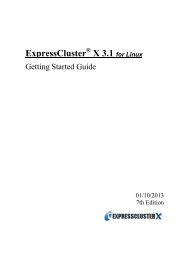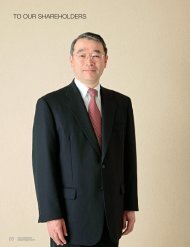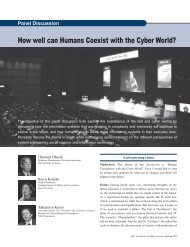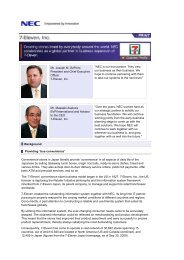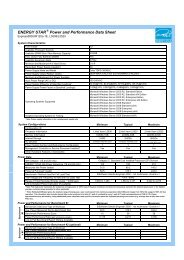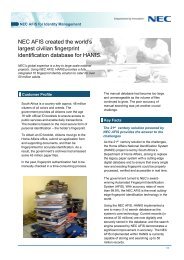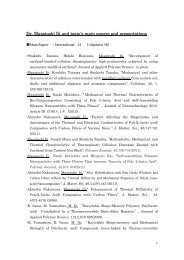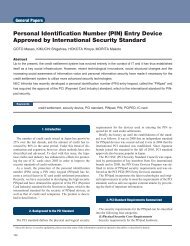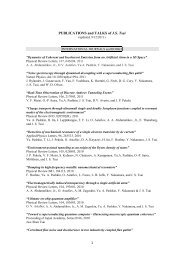Latest Technologies and the OCC-SC300 Optical Submarine Cable
Latest Technologies and the OCC-SC300 Optical Submarine Cable
Latest Technologies and the OCC-SC300 Optical Submarine Cable
Create successful ePaper yourself
Turn your PDF publications into a flip-book with our unique Google optimized e-Paper software.
Fundamental <strong>Technologies</strong> <strong>and</strong> Devices<br />
<strong>Latest</strong> <strong>Technologies</strong> <strong>and</strong> <strong>the</strong> <strong>OCC</strong>-<strong>SC300</strong> <strong>Optical</strong><br />
<strong>Submarine</strong> <strong>Cable</strong><br />
NISHIDA Takato, NAGATOMI Osamu<br />
Abstract<br />
This paper describes <strong>the</strong> technical features <strong>and</strong> characteristics of <strong>the</strong> <strong>OCC</strong>-<strong>SC300</strong> cable as used in <strong>the</strong> latest optical<br />
submarine cable systems. It also introduces DMF optical fiber, as applied to recent ultra-long distance D-WDM<br />
systems. In addition, a sea trial conducted for <strong>the</strong> integrated evaluation of <strong>the</strong> final stage of development of <strong>the</strong> <strong>OCC</strong>-<br />
<strong>SC300</strong> cable is reviewed.<br />
Keywords<br />
optical submarine cable, D-WDM, DMF, <strong>OCC</strong>-SC100, <strong>OCC</strong>-<strong>SC300</strong>, tight-type structure, loose-type structure<br />
1. Introduction<br />
Now that more than two decades have elapsed since <strong>the</strong> initial<br />
deployment of optical submarine cable systems, optical<br />
submarine cables have changed greatly, reflecting improved<br />
optical fiber properties <strong>and</strong> advancements in transmission<br />
technologies. In addition, <strong>the</strong> recent significant advances in IT<br />
have increased <strong>the</strong> need for optical submarine cables to be<br />
faster, less expensive, more reliable <strong>and</strong> easier to deploy.<br />
This paper describes <strong>the</strong> structure <strong>and</strong> characteristics of our<br />
latest optical submarine cable (<strong>OCC</strong>-<strong>SC300</strong>), toge<strong>the</strong>r with <strong>the</strong><br />
results of an experiment conducted at an actual seabed area.<br />
2. <strong>Optical</strong> <strong>Submarine</strong> <strong>Cable</strong> for Repeatered Systems (<strong>OCC</strong>-<br />
<strong>SC300</strong>)<br />
around a central steel wire <strong>and</strong> a UV-hardening resin filling.<br />
Following <strong>the</strong> recent increases in transmission capacities,<br />
large core fibers for D-WDM (Dense Wavelength Division<br />
Multiplexing) transmission are often used <strong>and</strong> we have already<br />
succeeded in developing <strong>OCC</strong>-SC100 optical cables<br />
employing such large core fibers (LMF: Large Mode-field Fibers)<br />
1), 2) . However, it was anticipated that tight type cable<br />
would have PMD characteristic limitations when optical transmissions<br />
of higher density <strong>and</strong> larger capacity are considered.<br />
Therefore, we have developed a loose type optical submarine<br />
cable (<strong>OCC</strong>-<strong>SC300</strong>) that exhibits less stress on <strong>the</strong> fibers<br />
while maintaining <strong>the</strong> excellent mechanical <strong>and</strong> electrical characteristics<br />
of <strong>the</strong> <strong>OCC</strong>-SC100 cable. Fig. 1 compares <strong>the</strong> PMD<br />
distribution of LMF in a tight structure with that of a loose type<br />
structure. The data shows that <strong>the</strong> loose type of cable can decrease<br />
<strong>the</strong> PMD, from its reduced fibers stresses. As seen here,<br />
<strong>the</strong> <strong>OCC</strong>-<strong>SC300</strong> cable structure makes it possible to reduce<br />
The Trans-Pacific optical submarine cable system has a<br />
length of about 10,000 km <strong>and</strong> it can reach depths in excess<br />
of 8,000 meters. The most important characteristic required for<br />
optical submarine cables for use in <strong>the</strong> construction of such<br />
long-distance repeatered systems is to protect <strong>the</strong> optical fibers<br />
from external forces. It should also maintain stability <strong>and</strong><br />
structural integrity for 25 years or more in <strong>the</strong> environment in<br />
which <strong>the</strong> cables are laid.<br />
The <strong>OCC</strong>-SC100 optical submarine cable developed in <strong>the</strong><br />
1980’s has already been manufactured <strong>and</strong> deployed for more<br />
than 140,000 km in various parts of <strong>the</strong> world. This is a tight<br />
type cable using cores composed of optical fibers twisted<br />
Fig. 1 Distribution of PMD.<br />
18
Special Issue on <strong>Optical</strong> <strong>Submarine</strong> <strong>Cable</strong> System<br />
costs while maintaining excellent optical characteristics, <strong>the</strong>refore<br />
currently being our main product for <strong>the</strong> optical submarine<br />
cable market 3), 4) .<br />
2.1 <strong>Optical</strong> Fibers<br />
The present subsection examines <strong>the</strong> latest optical fibers to<br />
be used in long-distance optical submarine cable systems for<br />
D-WDM transmissions.<br />
Recent long distance optical submarine cable systems employ<br />
Dispersion Management Fibers (DMFs). DMFs include<br />
two kinds of fibers; a fiber with positive dispersion <strong>and</strong> a positive<br />
dispersion slope (hereinafter DMF+) <strong>and</strong> a fiber with<br />
negative dispersion <strong>and</strong> a negative dispersion slope (hereinafter<br />
DMF-). They are configured with a line length ratio of<br />
about 2:1 so that <strong>the</strong> wavelength dispersion slope is almost 0<br />
(null). Table 1 shows <strong>the</strong> characteristics of DMF+ <strong>and</strong> DMF-.<br />
DMF+ <strong>and</strong> DMF- also differ in <strong>the</strong>ir effective areas characteristic.<br />
The DMF+ with a large effective area is placed on <strong>the</strong><br />
optical signal power input side <strong>and</strong> <strong>the</strong> DMF- with a small effective<br />
area is placed on <strong>the</strong> output side where <strong>the</strong> signal power<br />
is weakened in order to reduce nonlinear optical effects.<br />
2.2 LW <strong>Cable</strong><br />
Fig. 2 shows <strong>the</strong> structure of <strong>the</strong> <strong>OCC</strong>-<strong>SC300</strong> LW (Light<br />
Weight) cable.<br />
<strong>OCC</strong>-<strong>SC300</strong> cable is characterized by <strong>the</strong> direct insertion of<br />
optical fibers into a 3-divided steel segment pipe toge<strong>the</strong>r with a<br />
water blocking compound. This design allows omission of <strong>the</strong><br />
unit process, <strong>the</strong>reby reducing both <strong>the</strong>rmal stress on <strong>the</strong> optical<br />
fibers <strong>and</strong> manufacturing costs.<br />
Steel wires are twisted around <strong>the</strong> 3-divided steel segment<br />
pipe; a copper tape is <strong>the</strong>n formed around those, with <strong>the</strong> joint<br />
section TIG (Tungsten Inert Gas) welded. The welded copper<br />
tube encloses <strong>the</strong> steel wires, producing an integrated structure.<br />
Due to <strong>the</strong> use of fine tension control, slack control <strong>and</strong> stable<br />
copper tube welding technologies, long cables of (80 km or<br />
Fig. 2 <strong>OCC</strong>-<strong>SC300</strong>LW cable structure.<br />
more) with up to 16 optical fiber cores can be manufactured<br />
in a single continuous length.<br />
The LW cable is finally coated with a polyethylene sheath<br />
to electrically insulate <strong>the</strong> copper tube from <strong>the</strong> external environment.<br />
2.3 LWS (Light Weight Shielded) <strong>and</strong> Armored <strong>Cable</strong>s<br />
<strong>Optical</strong> submarine cables are provided with various structures<br />
for protecting <strong>the</strong>m against external damage depending<br />
on deployment environments. Particularly, in shallow sea areas<br />
near l<strong>and</strong>ing stations, cables are protected with an outer armor<br />
made of single or double layer of str<strong>and</strong>ed steel wires to<br />
prevent stress damage from fishing tools, anchors, etc. As <strong>the</strong><br />
potential for damage decreases proportionally with increased<br />
depths, LWS cables with light outer sheathing using iron reinforcement<br />
sheathing are used in all deep sea areas.<br />
Fig. 3 shows cross-sections of <strong>the</strong> structures of two types of<br />
<strong>OCC</strong>-<strong>SC300</strong> cables, <strong>the</strong> LWS <strong>and</strong> <strong>the</strong> SAL (Single Armored<br />
Light) types that are representative of outer armored cables.<br />
Table 2 shows <strong>the</strong> characteristics of various types of <strong>OCC</strong>-<br />
<strong>SC300</strong> cables.<br />
Table 1 Characteristics of DMF+ <strong>and</strong> DMF- (@ 1550 nm).<br />
Fig. 3 LWS <strong>and</strong> external cables structure.<br />
NEC TECHNICAL JOURNAL Vol.5 No.1/2010 ------- 19
Fundamental <strong>Technologies</strong> <strong>and</strong> Devices<br />
<strong>Latest</strong> <strong>Technologies</strong> <strong>and</strong> <strong>the</strong> <strong>OCC</strong>-<strong>SC300</strong> <strong>Optical</strong> <strong>Submarine</strong> <strong>Cable</strong><br />
Table 2 Characteristics of <strong>OCC</strong>-<strong>SC300</strong> cable series.<br />
Fig. 4 Variation of manufactured cable loss.<br />
3. Characteristics of <strong>the</strong> <strong>OCC</strong>-<strong>SC300</strong> <strong>Optical</strong> <strong>Submarine</strong><br />
<strong>Cable</strong><br />
3.1 Changes in Loss between <strong>Cable</strong> Manufacturing<br />
Processes<br />
Identifying changes in loss between cable manufacturing<br />
processes is one of <strong>the</strong> key issues in cable product. Particularly,<br />
as LMF with a large core is wound around a reel before it<br />
is used in manufacturing a cable, losses caused by this reel<br />
winding are important. This loss decreases after cable manufacturing<br />
since <strong>the</strong> fiber is loosened, but it is an important<br />
system design consideration to identify such changes in loss<br />
between manufacturing processes.<br />
Fig. 4 shows examples of changes in <strong>the</strong> loss between <strong>the</strong><br />
LMF cable manufacturing processes. Notably, as a result of <strong>the</strong><br />
cable manufacturing, fiber losses are improved by about 0.005<br />
dB/km <strong>and</strong> that subsequently, <strong>the</strong>ir characteristics become stable.<br />
These results indicate that <strong>the</strong> cable manufacturing does<br />
not produce micro-bends, etc.<br />
3.2 Temperature Characteristics<br />
<strong>Cable</strong> is manufactured at a room temperature of around 25°C<br />
but <strong>the</strong> temperature of ocean floors where <strong>the</strong> cable is actually<br />
deployed for long-term service is about 3°C. In addition, <strong>the</strong><br />
cable may experience significant temperature changes, for example<br />
between -20°C <strong>and</strong> +50°C, during transportation <strong>and</strong><br />
storage. Since <strong>the</strong> cable cannot avoid <strong>the</strong>se temperature impacts,<br />
it is essential to identify <strong>the</strong> temperature dependence of<br />
<strong>the</strong> optical loss characteristic with high accuracy <strong>and</strong> to<br />
Fig. 5 Temperature stability.<br />
reflect this in <strong>the</strong> system design.<br />
With <strong>OCC</strong>-<strong>SC300</strong>, we have applied temperature cycle testing<br />
to cable samples <strong>and</strong> have confirmed <strong>the</strong> temperature<br />
dependency of <strong>the</strong> optical loss characteristic shown in Fig. 5 .<br />
The figure shows that <strong>the</strong> temperature dependency of <strong>the</strong> LMF<br />
is 0.0001 dB/km/°C <strong>and</strong> that <strong>the</strong>re is no residual degradation.<br />
3.3 <strong>Cable</strong> Tensile Characteristics<br />
<strong>Optical</strong> submarine cable is subjected to tensile stresses from<br />
its own weight during laying <strong>and</strong> retrieval. Particularly, retrieval<br />
stresses may be as large as twice <strong>the</strong> weight of <strong>the</strong> cable.<br />
Tensile stress testing is conducted to check changes in <strong>the</strong> optical<br />
characteristics <strong>and</strong> degradation of <strong>the</strong> component parts<br />
resulting from such stresses. Some examples of tensile testing<br />
results are shown in Fig. 6 , illustrating tensile elongation<br />
<strong>and</strong> torque characteristics of <strong>SC300</strong> LW cable. At <strong>OCC</strong>’s tensile<br />
testing facilities, high-resolution optical measuring<br />
20
Special Issue on <strong>Optical</strong> <strong>Submarine</strong> <strong>Cable</strong> System<br />
While individual characteristics such as temperature dependency<br />
<strong>and</strong> tensile stress dependency can be evaluated in<br />
l<strong>and</strong> experiments as described above, sea trials are conducted<br />
as <strong>the</strong> final integrated evaluation for checking <strong>the</strong> degree of<br />
composite <strong>and</strong> dynamic changes. With <strong>OCC</strong>-S300, a deep sea<br />
trial was conducted on a span of LW cable about 40 km long<br />
in a seabed area with a maximum depth of 8,200 meters in <strong>the</strong><br />
Izu-Ogasawara (Bonin) Trench in November 2002.<br />
Although <strong>the</strong>re was concern about <strong>the</strong> instability of <strong>the</strong> loss<br />
characteristic when <strong>the</strong> loose type submarine cable was laid on<br />
<strong>the</strong> ocean floor, <strong>the</strong> test proved that <strong>the</strong> cable presents a stable<br />
loss characteristic with no problems.<br />
It has also been confirmed that no related issues were discovered<br />
in <strong>the</strong> h<strong>and</strong>ling properties of cables <strong>and</strong> jointing equipment<br />
during <strong>the</strong> actual laying procedure using a cable ship as<br />
well as for retrieval <strong>and</strong> re-laying.<br />
A shallow sea trial was also conducted on about a 20 km<br />
span of outer-shea<strong>the</strong>d cables (4 km of DA, 4 km of SAM, 7<br />
km of SAL <strong>and</strong> 6 km of LWS) in a seabed location with depths<br />
undulating between 700 <strong>and</strong> 2,700 meters to <strong>the</strong> east of Amami<br />
Oshima Isl<strong>and</strong> in February 2004.<br />
Similar to <strong>the</strong> results of <strong>the</strong> deep sea trial, <strong>the</strong>se test results<br />
were very favorable; <strong>the</strong> h<strong>and</strong>ling properties of <strong>the</strong> cables, repeaters<br />
<strong>and</strong> jointing equipment during <strong>the</strong> actual laying procedure<br />
using a cable ship were confirmed. There was no problem<br />
in <strong>the</strong> cable laying - retrieval - re-laying or re-retrieval of <strong>the</strong><br />
entire cable system <strong>and</strong> no issues such as cable undulations<br />
occurred.<br />
Fig. 6 Tensile elongation <strong>and</strong> torque characteristics of <strong>SC300</strong> LW<br />
cable.<br />
instruments are used to detect even small changes in optical<br />
characteristics <strong>and</strong> a long test length of 120 meters is applied<br />
to improve measuring accuracy.<br />
<strong>SC300</strong> cable has equivalent mechanical characteristics to <strong>the</strong><br />
SC100 cable <strong>and</strong> it is a highly reliable design by its reduced<br />
production of torque <strong>and</strong> small residual elongation after stressing.<br />
It has also been confirmed with optical loss variation<br />
monitoring that <strong>the</strong>re is no change in <strong>the</strong> optical fiber loss even<br />
after a tensile stress of up to NTTS (80 kN with LW cable) is<br />
applied.<br />
4. Sea Trials<br />
5. Conclusion<br />
After completing evaluation for <strong>the</strong> application of UJs (Universal<br />
Joints) in July 2004, <strong>the</strong> evaluation of <strong>the</strong> <strong>OCC</strong>-<strong>SC300</strong><br />
cable design was completed. <strong>OCC</strong>-<strong>SC300</strong> cable was first applied<br />
to <strong>the</strong> 350 km cable connecting India <strong>and</strong> Sri Lanka in<br />
2006 <strong>and</strong> <strong>the</strong>n for a 1,300 km cable in a project for <strong>the</strong> Maldives<br />
Isl<strong>and</strong>s in <strong>the</strong> same year. Since <strong>the</strong>n, it has been applied<br />
in various projects worldwide, including a transpacific project<br />
in Asia <strong>and</strong> in o<strong>the</strong>r projects in North American waters. We<br />
were also able to accomplish <strong>the</strong> first application of a DMF<br />
cable in <strong>the</strong> IWM <strong>and</strong> Unity projects. The total amount of<br />
manufacturing up until completing <strong>the</strong> Unity project had by<br />
<strong>the</strong>n reached 28,000 km.<br />
In <strong>the</strong> future, <strong>OCC</strong> will continue to contribute to <strong>the</strong> construction<br />
of optical submarine cable networks both inside <strong>and</strong><br />
outside Japan by continuing to supply high-quality cables.<br />
NEC TECHNICAL JOURNAL Vol.5 No.1/2010 ------- 21
Fundamental <strong>Technologies</strong> <strong>and</strong> Devices<br />
<strong>Latest</strong> <strong>Technologies</strong> <strong>and</strong> <strong>the</strong> <strong>OCC</strong>-<strong>SC300</strong> <strong>Optical</strong> <strong>Submarine</strong> <strong>Cable</strong><br />
References<br />
1) Juan C. Aquino, et al., “Development of High-Count Tight Type Fiber<br />
Unit for <strong>Submarine</strong> <strong>Cable</strong>s”, 49th IWCS, pp.607-612 (2000).<br />
2) Kazuto Yamamoto, et al., “Tight Type Fiber Unit <strong>Optical</strong> <strong>Submarine</strong> <strong>Cable</strong><br />
with DMF for Ultra Long-Haul DWDM <strong>Submarine</strong> System”, 50th<br />
IWCS, pp.758-763 (2001).<br />
3) Mareto Sakaguchi, et al., “Development of 3-Divided Segment Loose<br />
Tube <strong>Optical</strong> <strong>Submarine</strong> <strong>Cable</strong> <strong>and</strong> <strong>Cable</strong> Joints”, 52nd IWCS, pp.<br />
586-591 (2003).<br />
4) Nobuaki Matsuda, et al., “New High Reliability <strong>OCC</strong>-<strong>SC300</strong> <strong>Cable</strong> <strong>and</strong><br />
<strong>Cable</strong> Joints for Long-Haul <strong>Submarine</strong> <strong>Cable</strong> Systems”, 53rd IWCS, pp.<br />
583-588 (2004).<br />
Authors' Profiles<br />
NISHIDA Takato<br />
Executive Manager<br />
Engineering Department<br />
<strong>Submarine</strong> System Plant<br />
<strong>Submarine</strong> Business Unit<br />
<strong>OCC</strong> Corporation<br />
NAGATOMI Osamu<br />
Manager<br />
Engineering Department<br />
<strong>Submarine</strong> System Plant<br />
<strong>Submarine</strong> Business Unit<br />
<strong>OCC</strong> Corporation<br />
22



